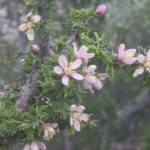Guayacan, Soapbush
Guaiacum angustifolium
Melastomataceae, Zygophyllaceae (Caltrop family)
Description
Guayacan is a common component of the South Texas brush country. Guayacan is an unusual evergreen shrub, or small tree reaching up to 20 ft or 6 m, in the Caltrop Family (Zygophyllaceae). It has a short trunk and a clump-like dense crown often growing in colonies. It has extremely hard wood, and its branches are so short that the leaves seem to be growing from the stem. The thick, leathery, lustrous, dark green leaves, which fold inward during the heat of the day and night to conserve water, are pinnate and have tightly clustered groups of 4 to 8 pairs of pinnae with tiny linear-oblong leaflets (to 2 cm) that grow in pairs. From March to April, its numerous star-shaped fragrant flowers bloom. Each is about 2.5 cm wide and has 5 violet, purple, or pink petals; 5 sepals; and 10 stamens with noticeably yellow anthers. Guayacan tends to bloom after receiving precipitation. The fruit is a 1.25 cm yellow capsule and has 1 to 3 shiny red, orange, or yellow seeds. The capsule is heart-shaped, mostly two-lobed, and with somewhat winged margins. Guayacan offers good forage for deer and small mammals such as rabbits and rodents and excellent cover for birds and small mammals. Bees drink its nectar and caterpillars munch on its leaves. One of its common names, Ironwood, references its being one of the hardest woods in the United States.Habitat
Guayacan is found on dry, poor upland soils of south and west Texas.Images
Plant Characteristics
Flower Color: Pink, Purple
Seed Type: Capsule
Duration: Perennial
Stem Texture: Hairless/Smooth
Growth Habit: Shrub (Woody)
Leaf Shape
 : Pinnately Compound
: Pinnately Compound
Season: Evergreen
Distribution
 : 02 - Gulf Prairies and Marshes, 05 - Cross Timbers and Prairies, 06 - South Texas Plains, 07 - Edwards Plateau, 10 - Trans-Pecos
: 02 - Gulf Prairies and Marshes, 05 - Cross Timbers and Prairies, 06 - South Texas Plains, 07 - Edwards Plateau, 10 - Trans-Pecos
Distributions
Distribution refers to the ecological region in Texas that a plant has been found. You can also view a clickable map.
Collection: Brush and Weeds




